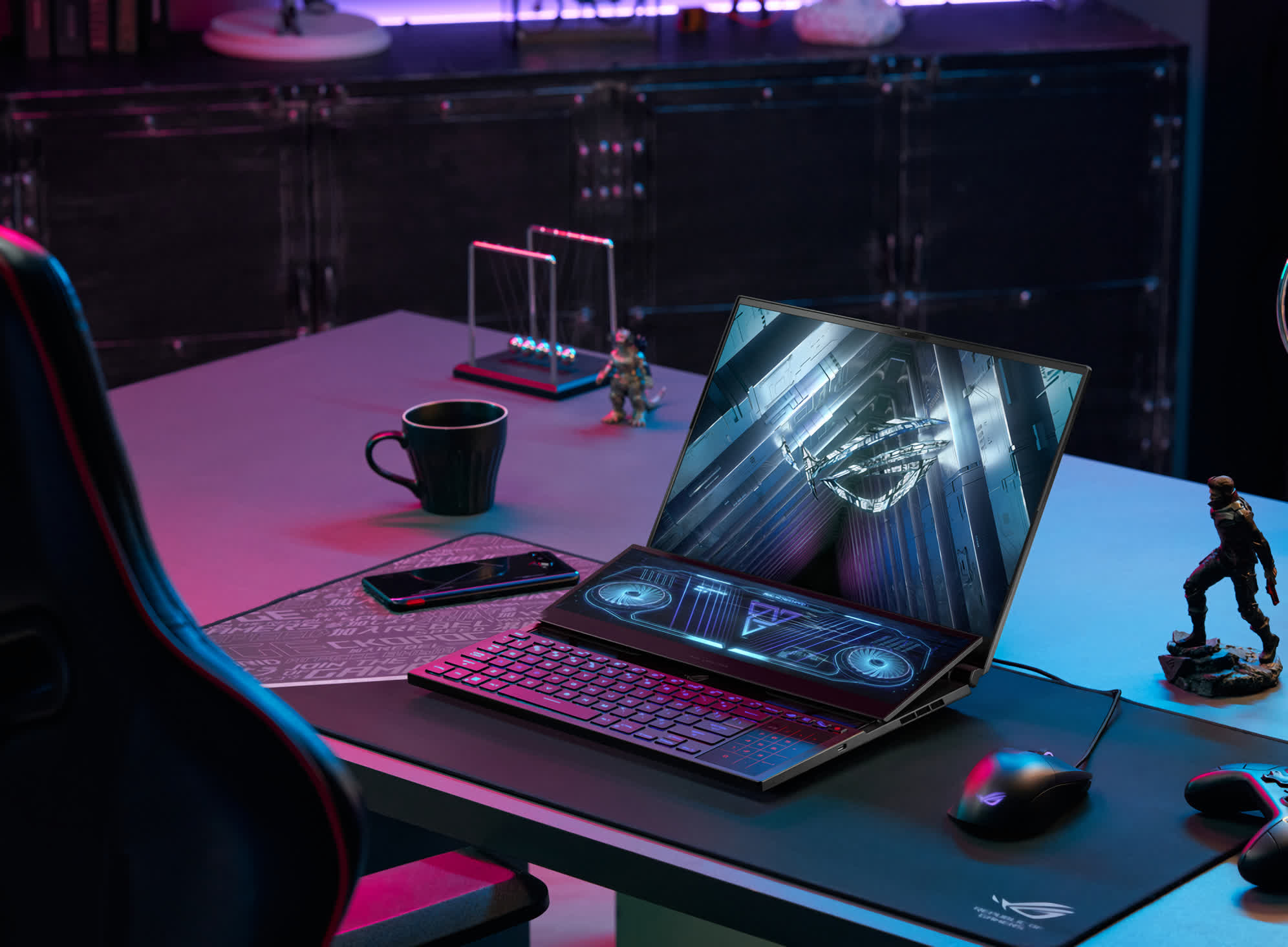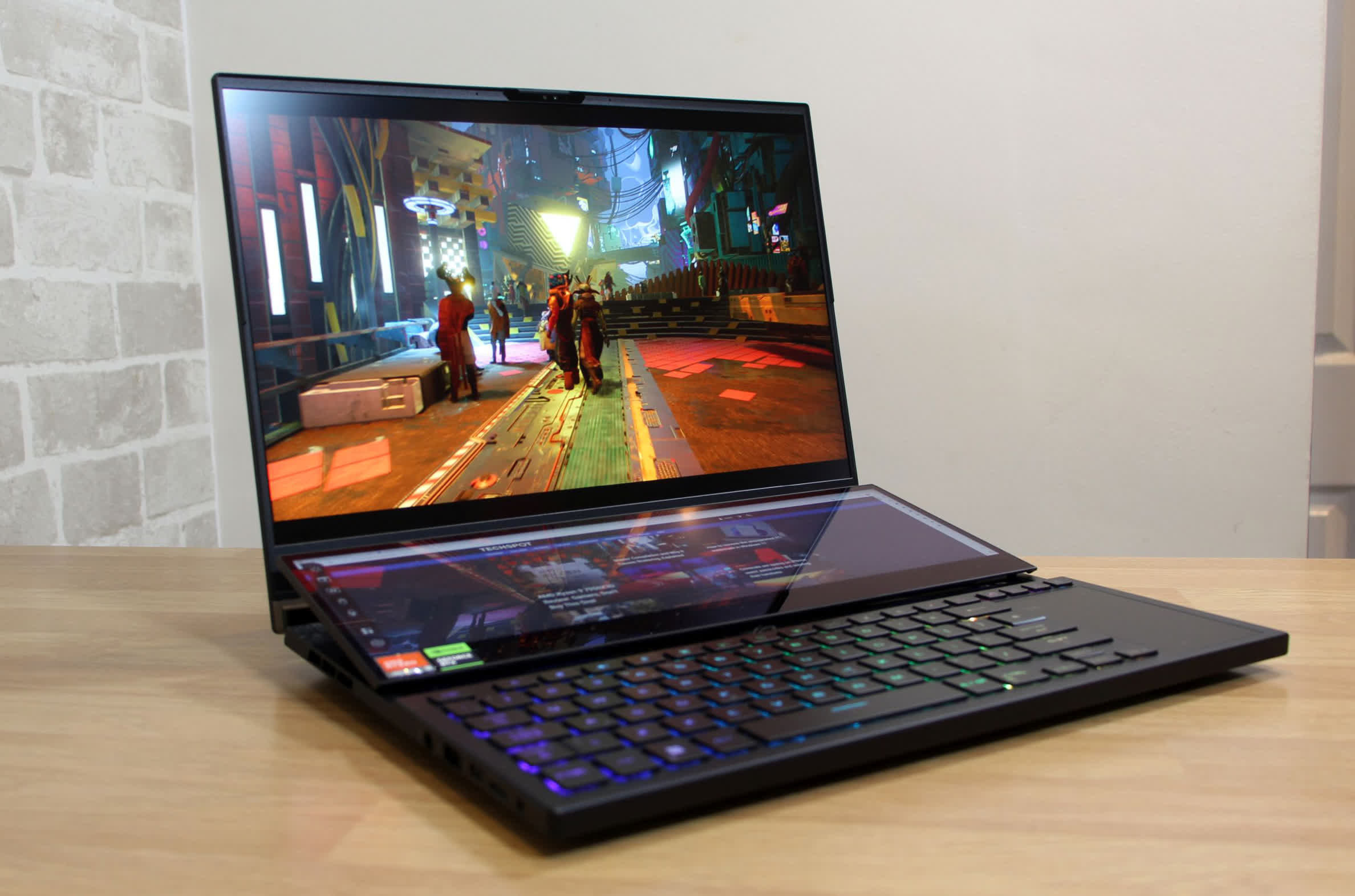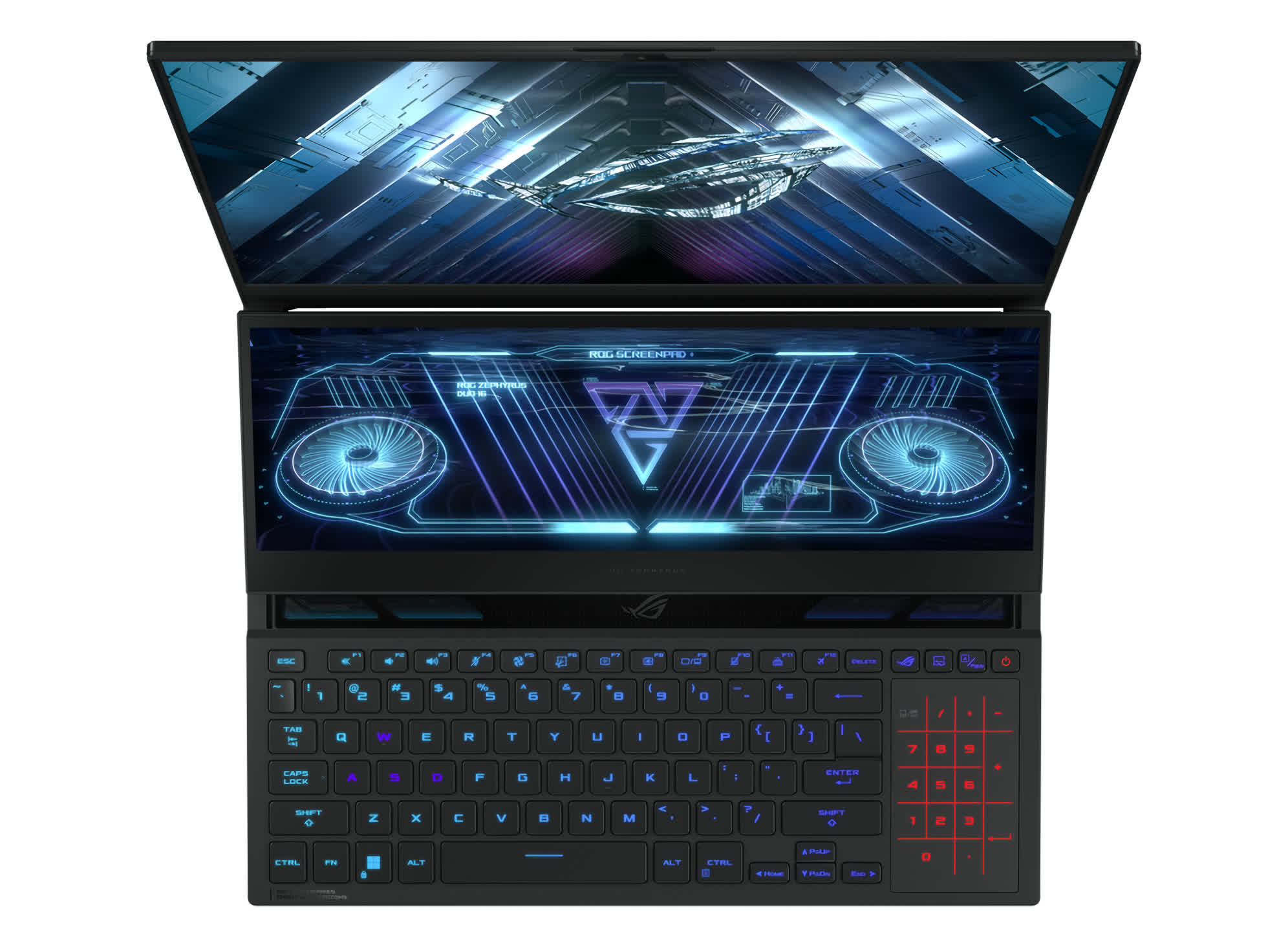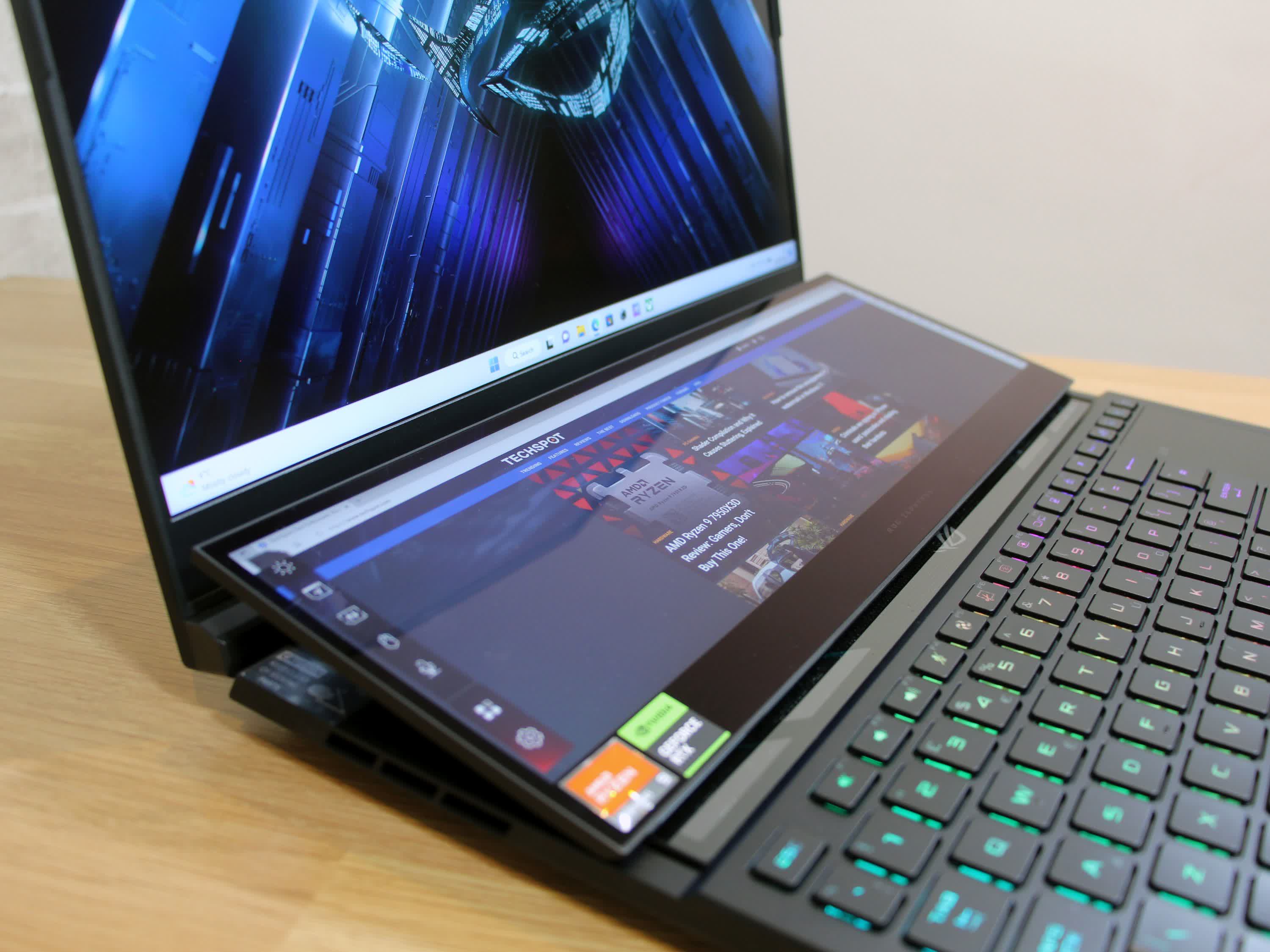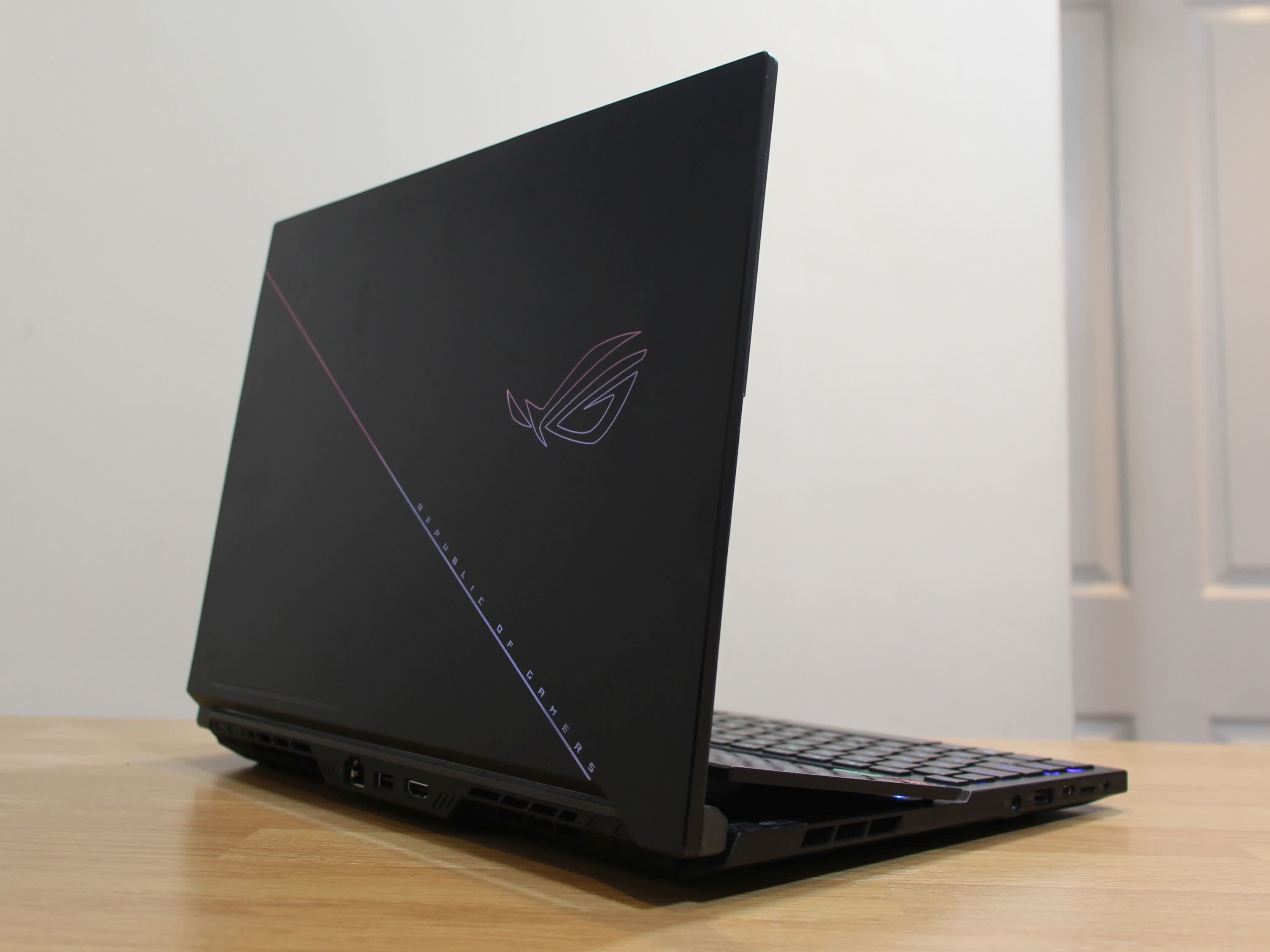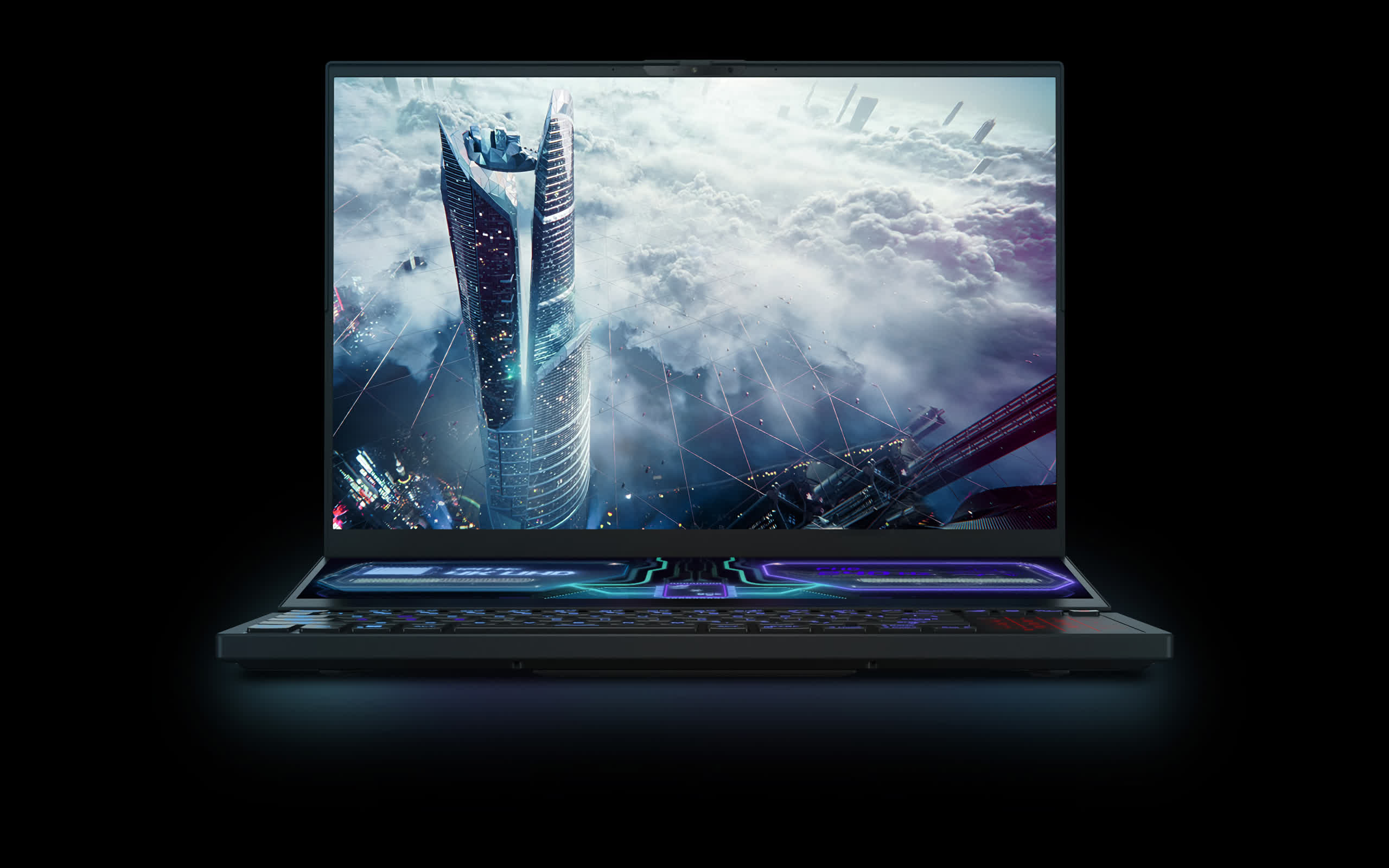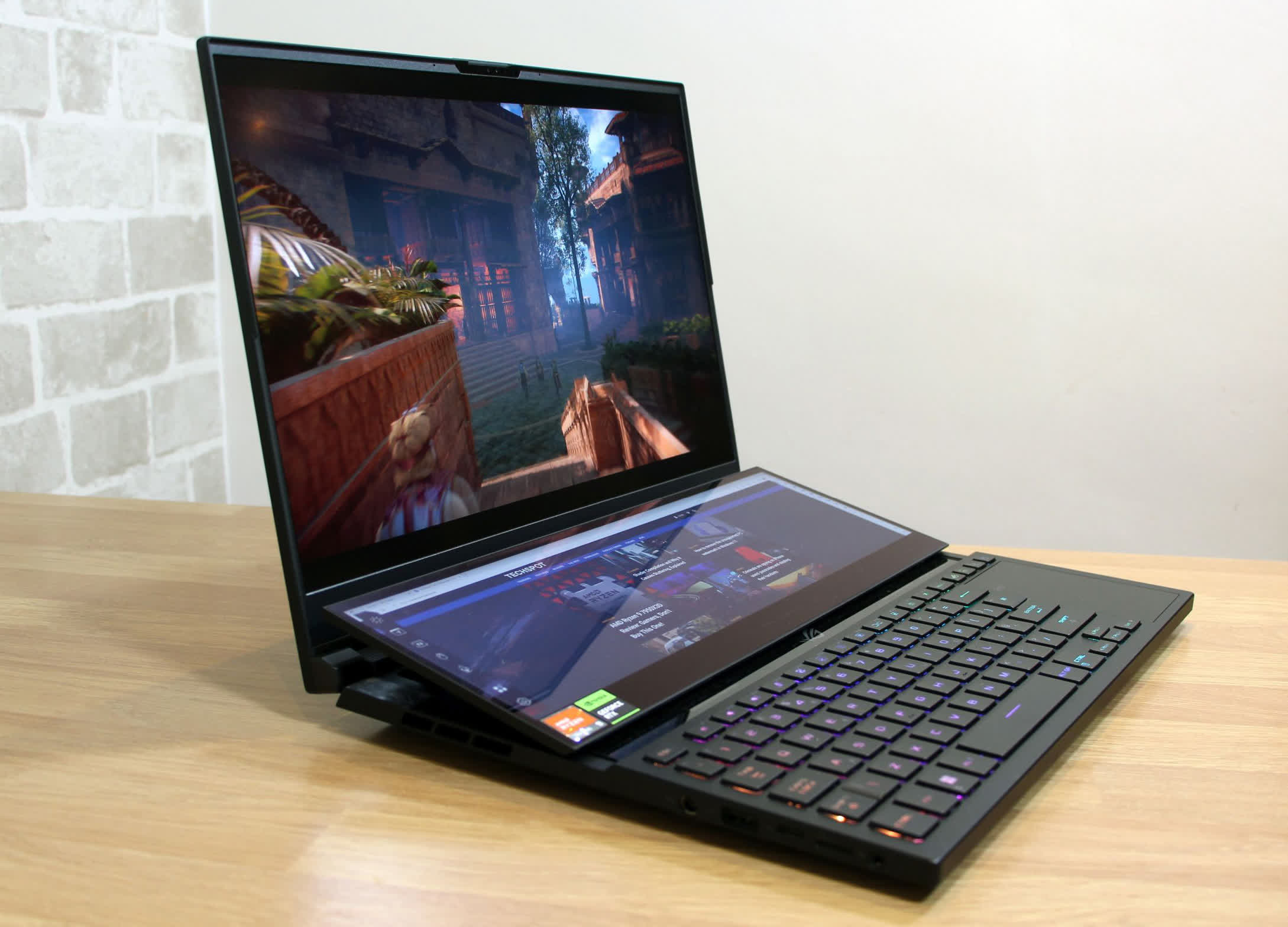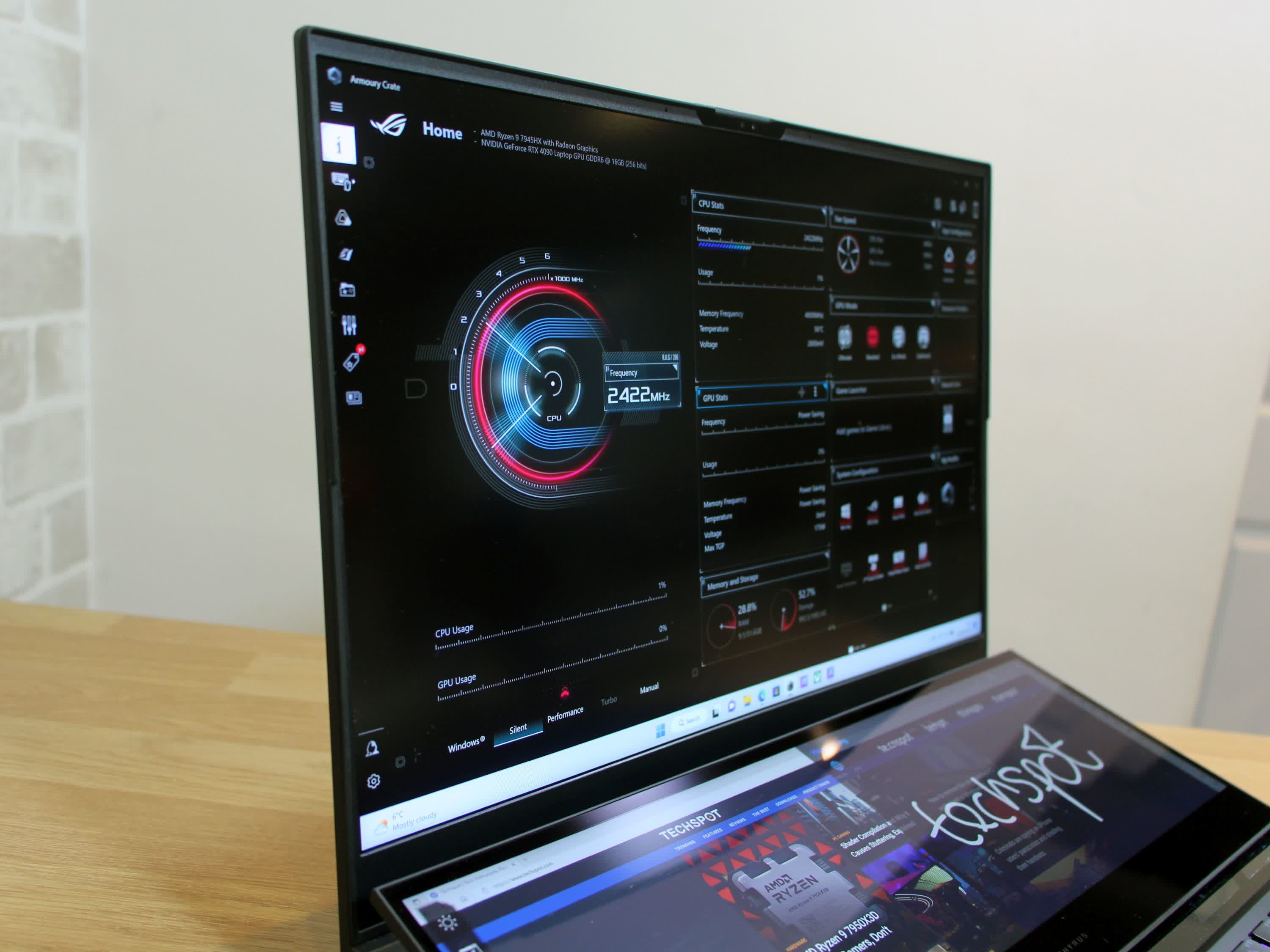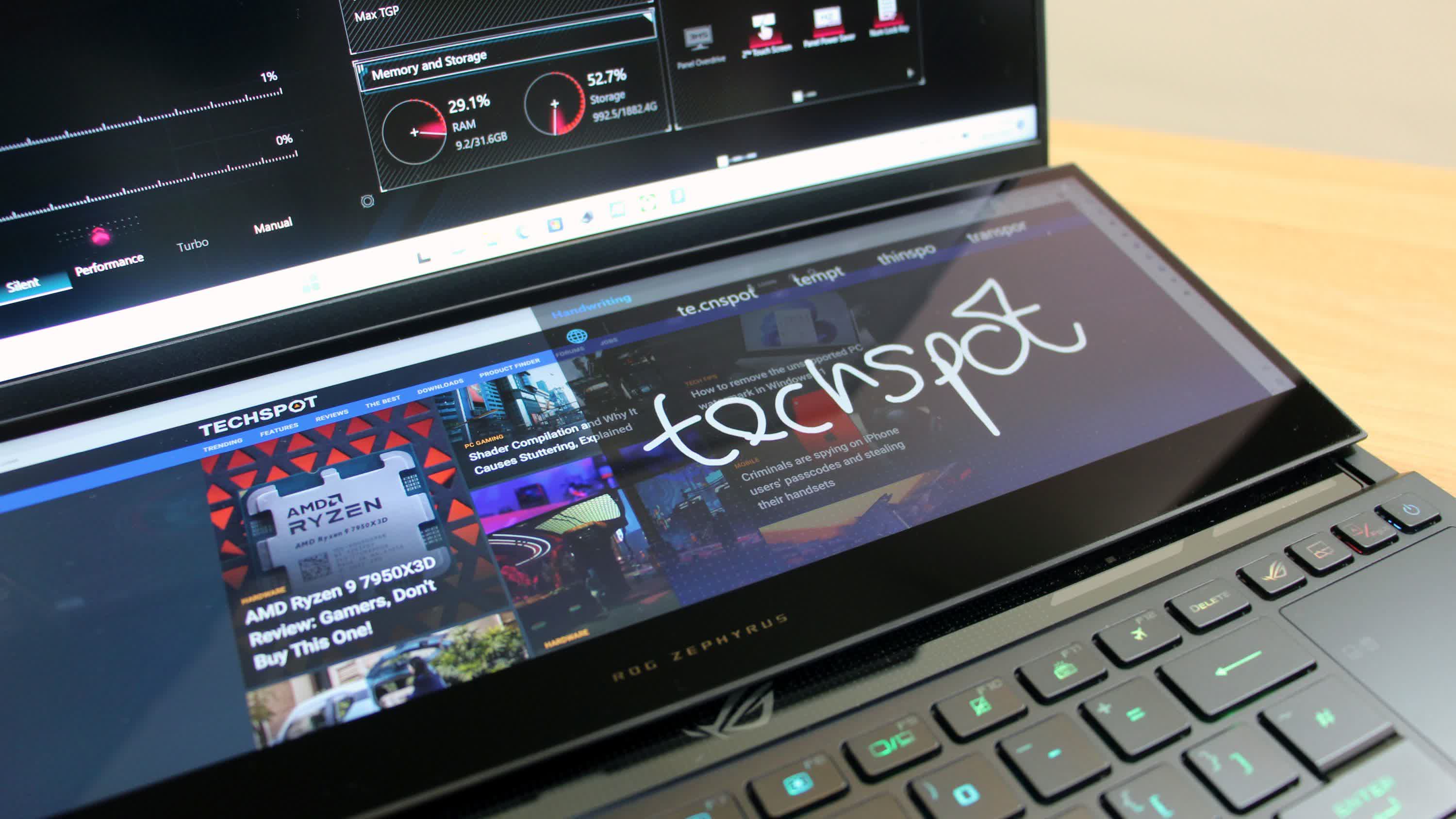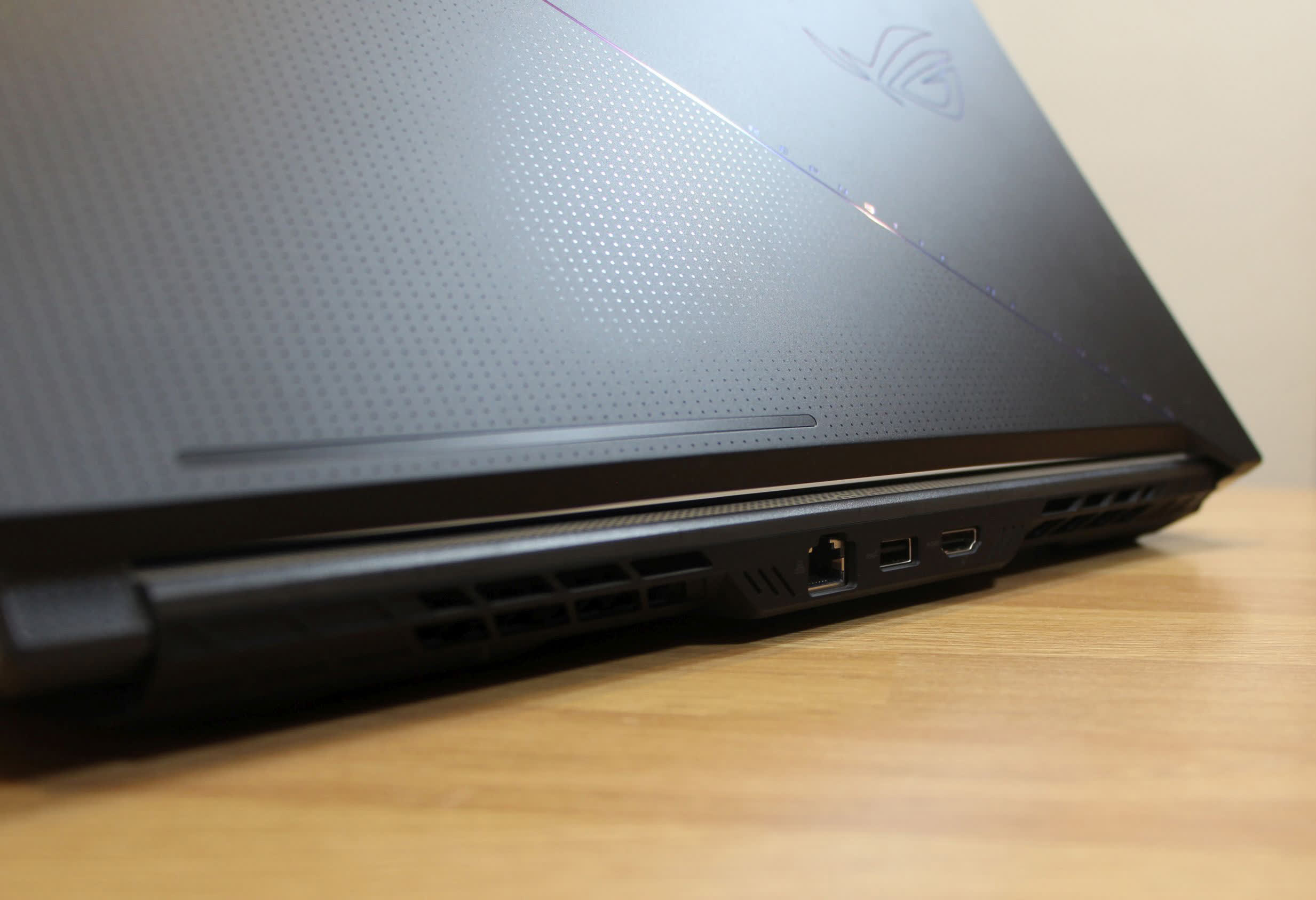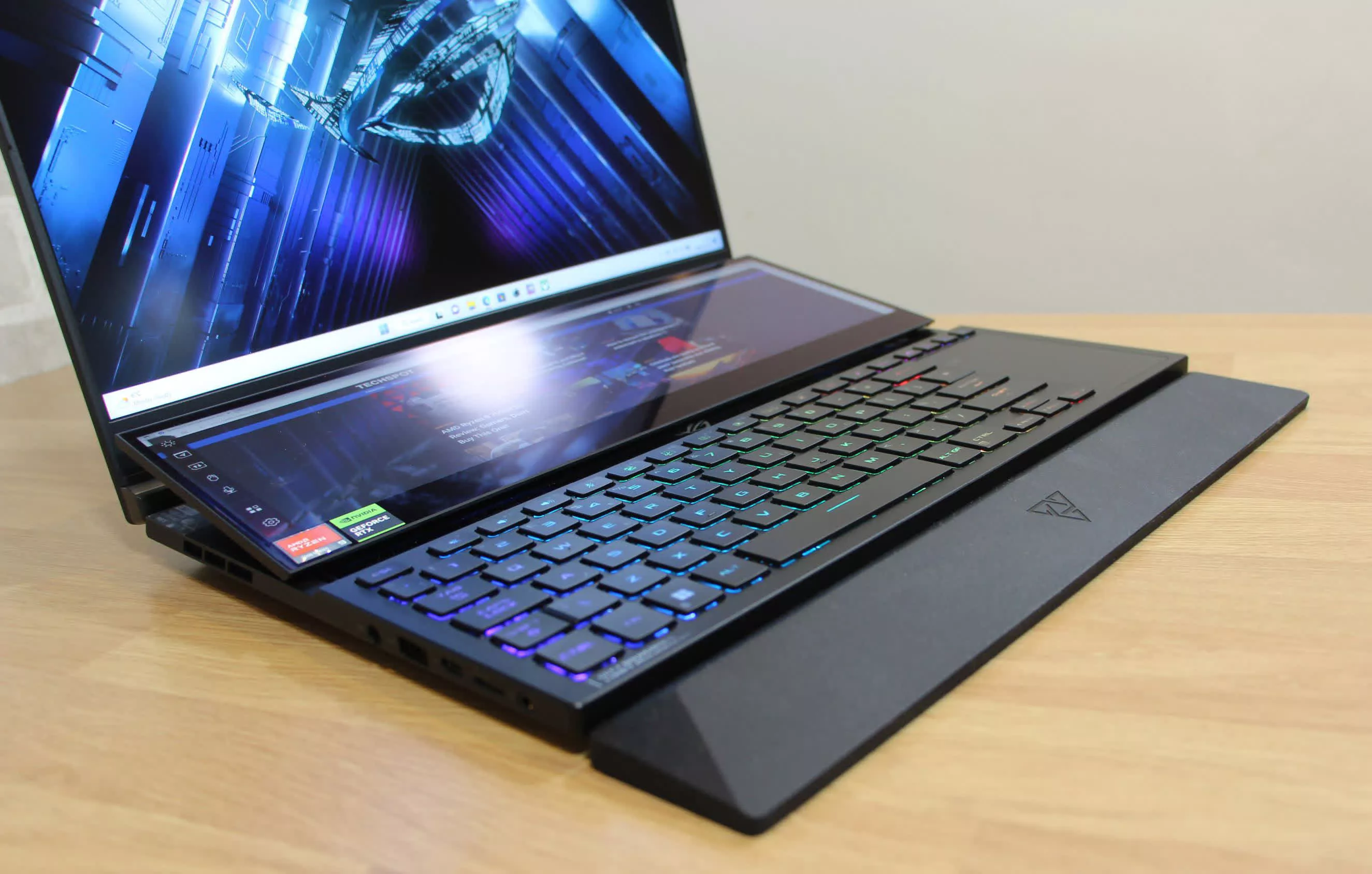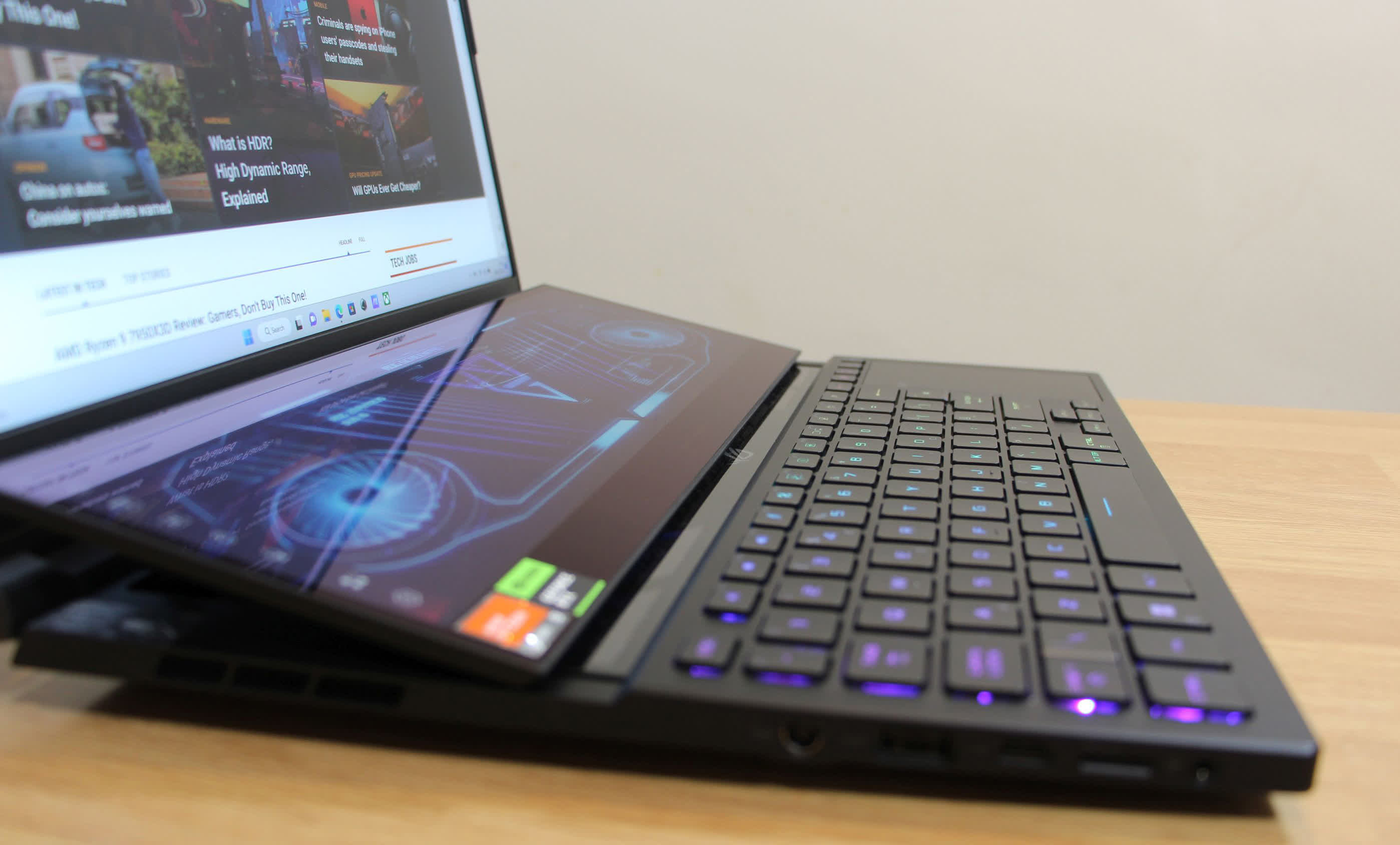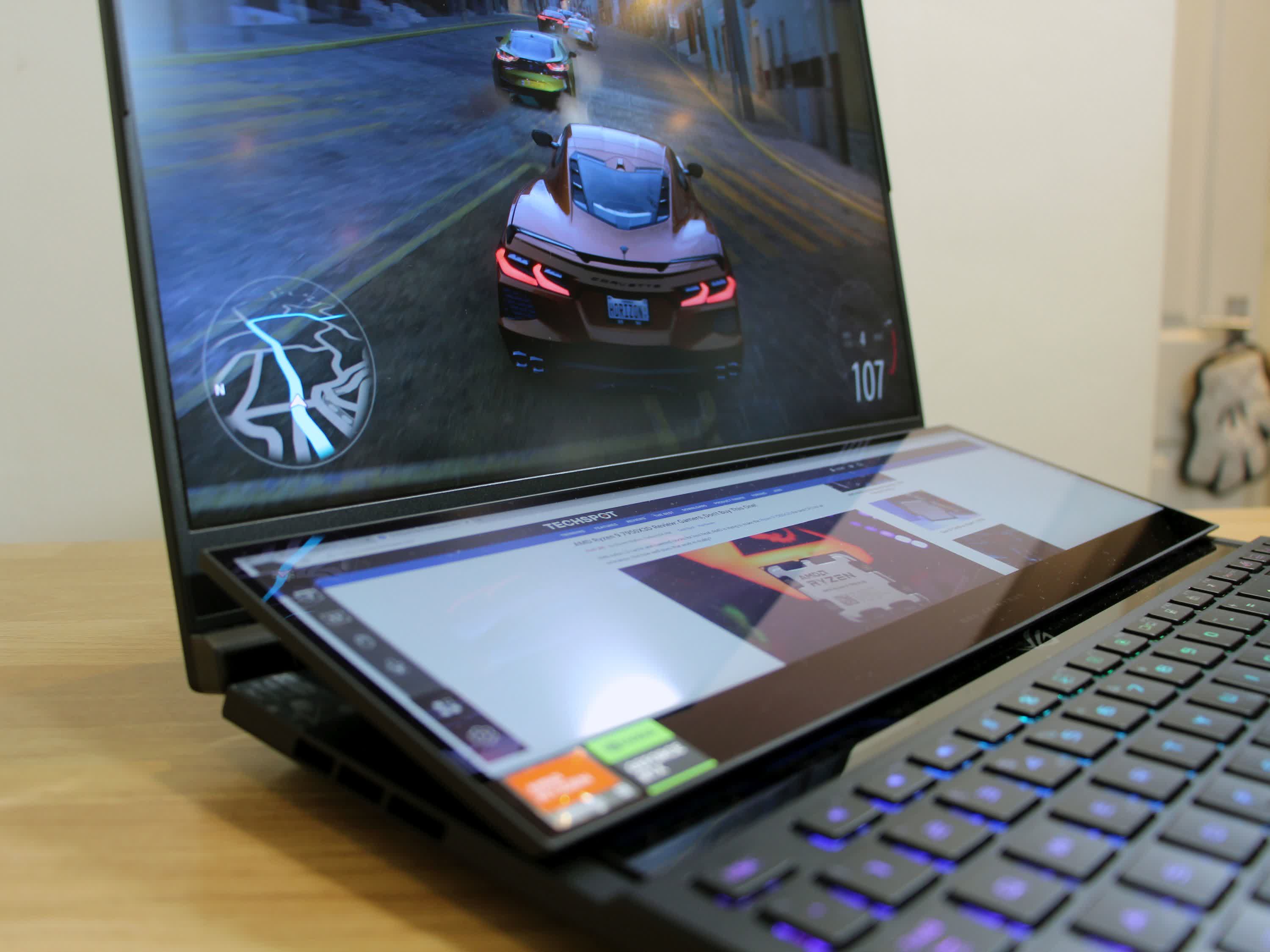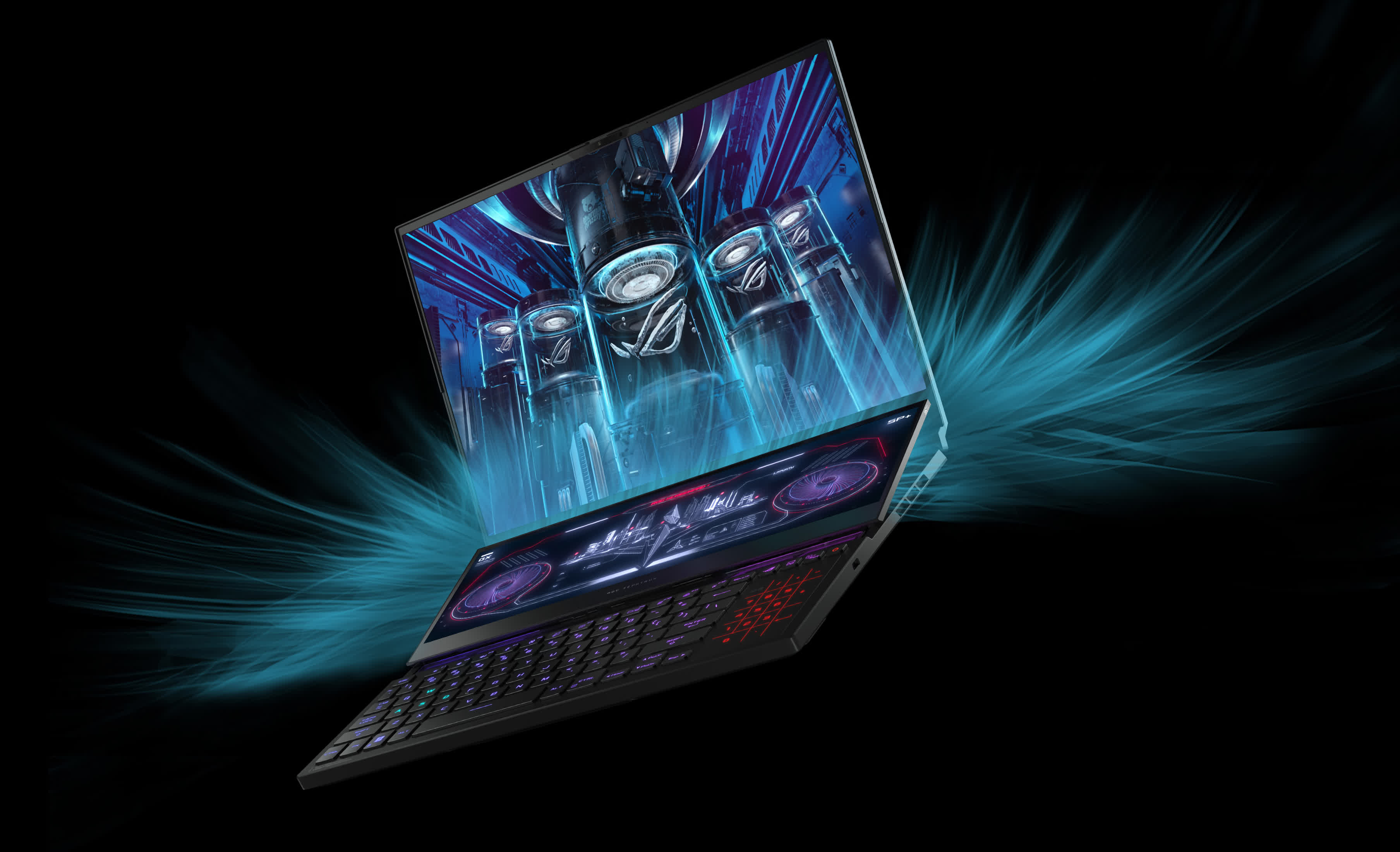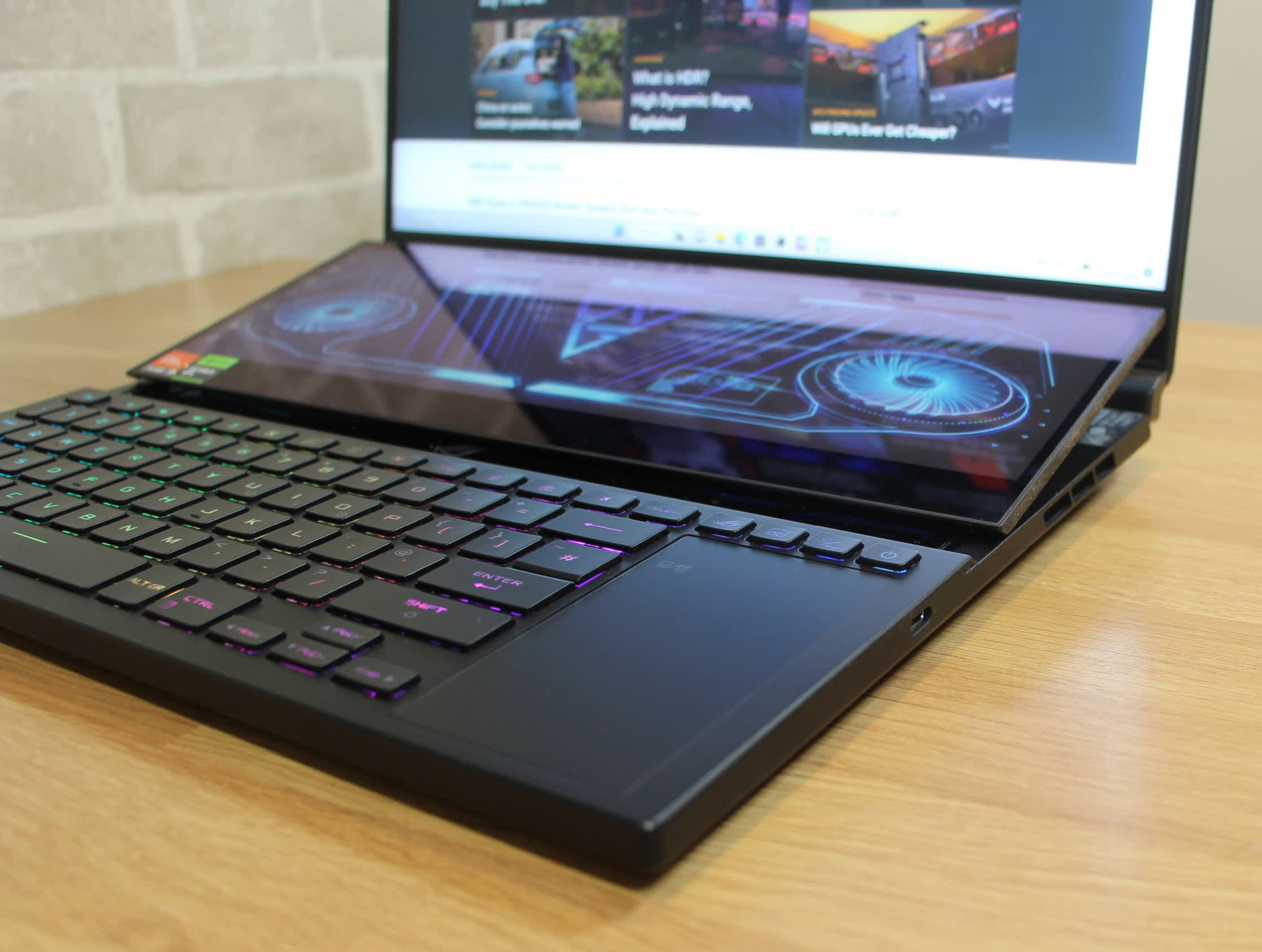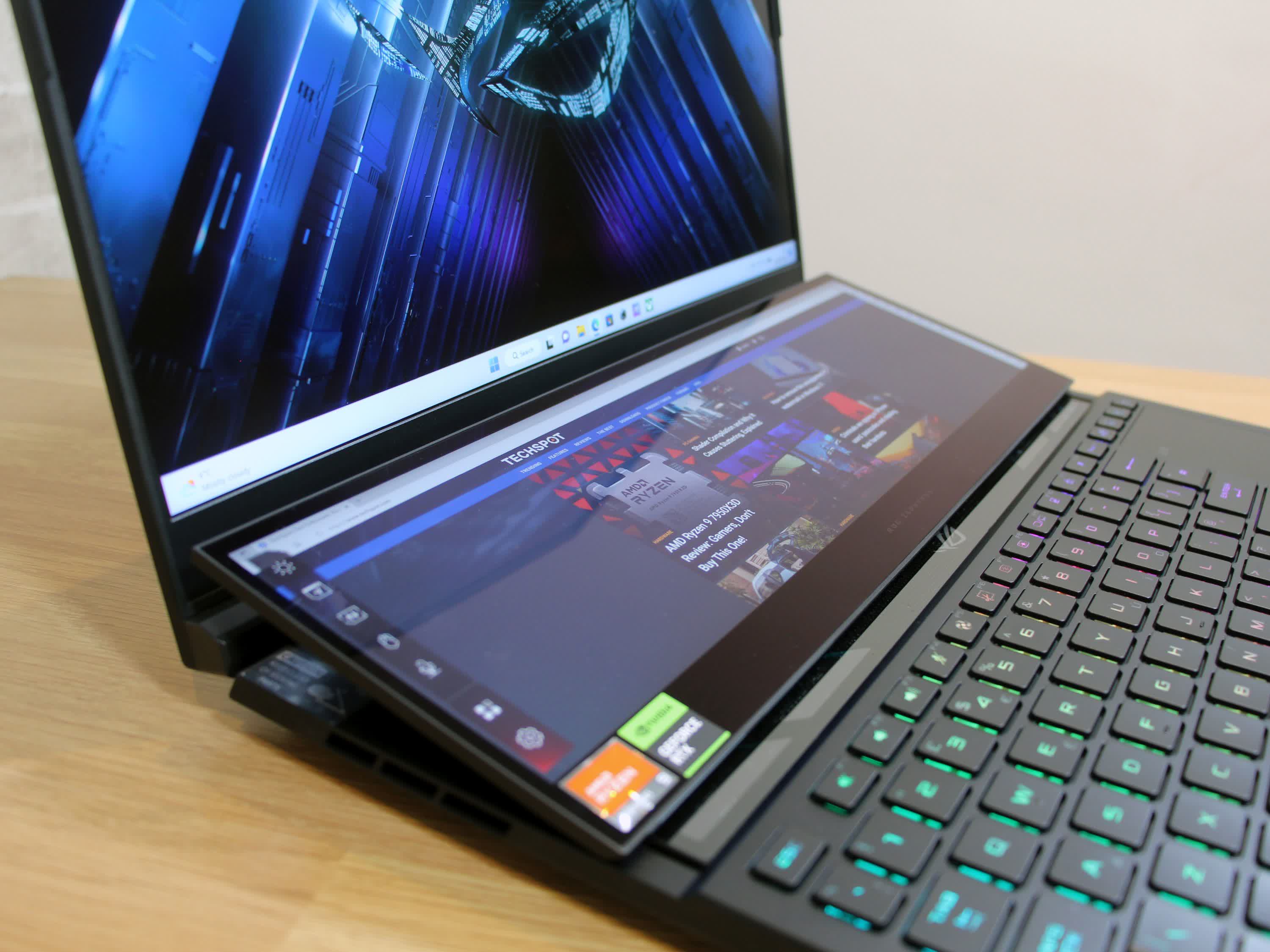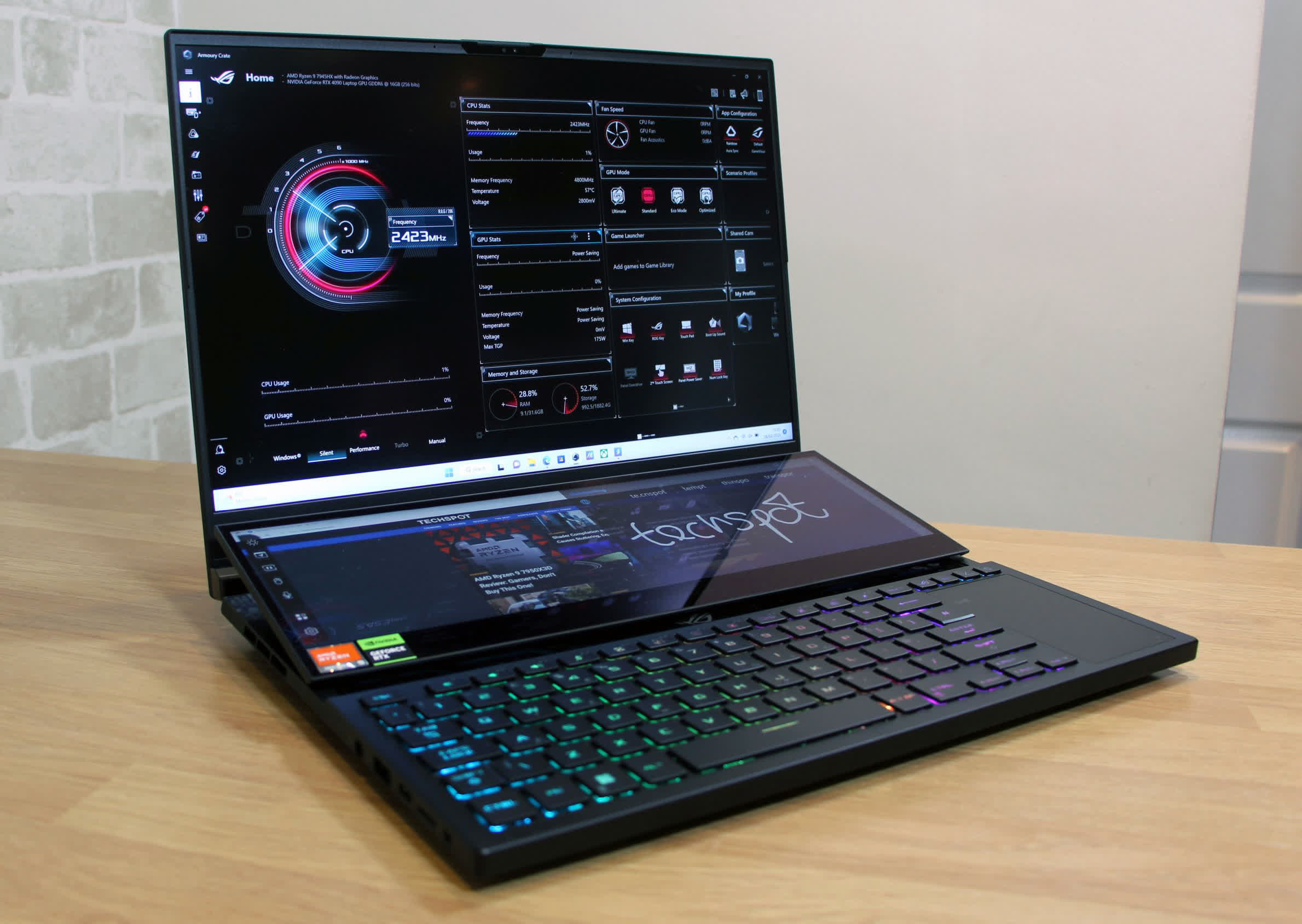Flagship laptops are like supercars: fun, fast and eye-catching, but with pricing that puts them out of reach of most people and features that many of us won't ever need. The Asus ROG Zephyrus Duo is a prime example of that. It's a stunning machine with some fantastic engineering, and it's undoubtedly going to attract admiring glances - but it's pricey, and most people just won't need all the extra features.
As the name suggests, this is a dual-screen laptop, with a secondary touchscreen crammed between the keyboard and main panel. On the inside, the Duo has flagship components to power the pair of panels.
And while this is a laptop from the Asus gaming range, it's not just about playing the latest titles - Asus reckons it's also ideal for streamers who want a second screen to host comms and management apps and creatives who need space for timelines and extra apps.
If you do need the laptop world's latest supercar-style design, be prepared to spend plenty. The model we've reviewed, the Zephyrus Duo 16 GX650PY-XS97, costs a cool $4,000 - and if you want the more affordable version without flagship Nvidia graphics, the GX650PZ-XS96 still costs $3,500.
It's not cheap, and it's not the only contender at the top of the market. Asus' own ROG Zephyrus M16 remains the slimmest, lightest RTX 4090 notebook around, and forthcoming devices like the Razer Blade 16 and Alienware m16 stake their claims for gaming and creative dominance. We also tested the MSI Titan GT77 in our review of the laptop RTX 4090.
Features and Design
The two screens influence most areas of the Duo's design. The secondary panel's inclusion forces the keyboard forward to the laptop's front edge, and the trackpad must find room to the right - and it's much narrower than the conventional cursor surface.
Open the laptop and an intricate mechanism lifts that second screen up to an angle of 13 degrees - a move that improves airflow and makes it easier for users to see the ScreenPad. And, new for this year, a small strip of glass beneath the second screen allows users to see the motherboard alongside RGB LEDs. It's a bit pointless, and that space would have arguably been better used to make the keyboard a bit less cramped.
There's plenty of innovation on show, and the Zephyrus does look futuristic. In addition to the window and the RGB LEDs between the ScreenPad and keyboard, more lighting is installed in the keyboard and the lid has an iridescent slash. It's not a shy notebook - Razer rigs in particular look more reserved.
It's not weak, either. The Duo's build quality is consistently excellent and all of its mechanisms move smoothly and reliably.
The powerful internals and innovative design do mean that the Duo isn't the slimmest or lightest notebook. This particular Asus weighs 5.9 pounds and it's 30mm thick - and 266mm from front to back. The power brick weighs an additional 2.5 pounds, which is standard at this level.
If you want something slimmer and lighter, the Razer Blade 16 weighs 5.4 pounds and it's just 22mm thin. Asus' own ROG Zephyrus M16 is slimmer and lighter than the Duo, too.
Unsurprisingly, the MSI Titan GT77 is far heavier and thicker than the Duo. The Alienware m16 is a hefty unit, too, with a 7.1-pound body that stretches 290mm from front to back.
The Displays
Both screens have impressive specifications. The main panel is a 16" Mini LED display with 1,024 dimming zones and a 2560 x 1600 resolution. If you want impeccable contrast and crisp visuals, you're in luck.
It's an improvement over older versions of this laptop, which retained many of the same features but with IPS underpinnings.
It's a 16:10 screen, so there's a bit more vertical space for working and browsing. All but the keenest esports players will be sated by the 240Hz refresh rate and 3ms response time. It also has AMD FreeSync Premium Pro.
The ScreenPad Plus is a 14" panel with a 4K-equivalent resolution of 3840 x 1100 - a resolution chosen to ensure there's no difference in size or fidelity when flipping apps between the displays (kudos for that decision).
The ScreenPad isn't Mini LED, but it is IPS. It's also a Gorilla Glass touchscreen that supports a stylus, although you don't get one in the box.
Asus reckons that people will find plenty of uses for the ScreenPad Plus. You can dock any app on the ScreenPad, so it's an ideal home for media or comms tools while you're gaming or working. You could use Asus Armory Crate to tweak the laptop while you're playing. Streamers - who need to manage multiple apps while playing - will find the ScreenPad more useful than conventional gamers.
Creatives can put timelines or controls on the ScreenPad alongside other secondary tools, and the Asus Control Center has dedicated dials, sliders, buttons and controls for Adobe apps like Photoshop, Lightroom, Premiere Pro and After Affects.
The Asus Screen Xpert app manages the display, and it works well - users can save custom layouts, configure apps to open on the ScreenPad by default and create groups to open loads of apps on-command on different screens. It's pretty intuitive and easy to manage.
There's no shortage of quality on offer from either display. In HDR mode the main panel hits a monster brightness of 1,047cd/m2 and in SDR mode the revised brightness level of 752cd/m2 is huge.
Combine that with black levels that hover at around 0.05cd/m2 and you're going to get contrast levels that hit 15,000:1. That means incredible punch in any gaming or media situation. It's a far better panel than any IPS display and you'll only get a minor improvement with OLED. The Asus M16 offered better contrast, but at this level differences are minimal and in most situations not noticeable.
The Delta E of 1.52 is excellent, and the color temperature of 6,613K is another superb result. The Gamma average of 2.19 barely deviates from the ideal 2.2 figure. These three results all ensure that colors are so accurate that human eyes won't detect any issues.
The Duo's main display will render virtually any shade needed by games. It produced 99.9% of the sRGB gamut at 144.8% volume and handled 98.5% and 102.6% of the DCI-P3 space. They're great results - perfect for SDR gaming and well-suited to HDR. Combine those latter results with the huge brightness and ample dimming zones and you'll see genuine contrast, brightness and depth gains in HDR titles.
This is easily one of the best screens in any gaming laptop. The contrast, brightness and colors combine to deliver unmatched vibrancy in games - to say everything pops is an understatement. Movies and TV shows look fantastic, too, with loads of depth and nuance.
The only slight issue is an Adobe RGB coverage level of 89.2%, which is on the low side - the most demanding designers should shop elsewhere.
None of the Duo's rivals go beyond this machine in terms of quality and there's little significant difference between the Duo and the M16, but it's worth shopping elsewhere if you want something different from your display. The Razer Blade 16 has a 3840 x 2400 panel at 120Hz that can switch to a 1920 x 1200 @ 240Hz mode and the Alienware m16 is available with a 480Hz upgrade for esports.
The ScreenPad is a capable secondary panel but it doesn't have the quality for creative tasks. Its peak brightness level of 393cd/m2 is fine for any indoor situation, and it produced 96.2% of the sRGB color gamut with a great Delta E of 1.8 - but delivered sub-70% figures in the DCI-P3 and Adobe spaces.
Input and Connectivity
Some aspects of the Duo's design may have been compromised due to the secondary display, and you'll have to accept some limitations when it comes to connectivity.
The left-hand edge has two USB 3.2 Gen 2 ports and a sole USB 3.2 Gen 2 Type-C connector that handles DisplayPort and 100W of power delivery. Another one of those USB-C connectors occupies the right-hand edge. You'll find a microSD card slot, audio jack, HDMI 2.1 output, and a 2.5Gbps Ethernet connection at the back.
That's not a bad array of ports, but the AMD processor and chipset mean no support for Thunderbolt 4. A full-size SD card slot would have been welcome.
Internally, the Duo pairs that 2.5Gbps Ethernet with Wi-Fi 6E and Bluetooth 5.2, so we've got no complaints. The 1080p webcam offers good quality and supports Windows Hello, but there's no privacy shutter and the Duo doesn't have a fingerprint reader.
The final notable feature on the inside is the sextet of speakers, which provide clear, crisp and loud noise that could be made even better with a little more bass. Still, they're good enough for everyday gaming and media and don't hinder the Duo.
We do have a complaint about the internal access - the base panel is held in place with Torx screws and a hidden screw beneath a rubber pad, and it should not be that difficult to get inside. When you do, at least, there are pairs of SO-DIMM and M.2 slots for upgrades.
The ports may be a bit compromised, but that's nothing compared to the ergonomics. The keyboard is very cramped: you'll have to endure a single-height Return key and small cursor buttons. There's no number pad, just an awkward overlay on the trackpad. And because the keyboard pushes right up against the laptop's front edge, you don't get a wrist rest.
As with previous models of the Zephyrus Duo, Asus includes a rubberized wrist rest instead. It helps a little but doesn't attach to the laptop, so movement shoves it out of sync. At least make it magnetic.
It's a shame, because the keys themselves are pretty good. They're fast, snappy and satisfying, so you can easily hammer through documents and games. The keyboard has per-key RGB LED lighting and it's pretty quiet, and on feel alone it easily competes with the kit you'll find on Razer and Alienware machines - unless you pay for the mechanical upgrade on the latter.
The trackpad offers fine accuracy and a smooth surface, but its narrow design means you can't even move the cursor across the screen with a single swipe. For everyday computing it's passable, but it's not effective enough for any precise creative work or gaming. Attach a USB mouse instead.
You won't find a number pad on rivals from Razer and Alienware, but every rival is more ergonomic thanks to spacious keyboards and larger trackpads. The Alienware has Cherry MX mechanical upgrades, too, and the MSI Titan GT77 comes with mechanical hardware by default.
Performance
Nvidia's GeForce RTX 4090 deploys its 9,728 shader units and the GPU can use its full TDP of 150W with 25W of dynamic boost in this rig, although the Duo's Turbo profile limits that figure to an overall 155W - you'll have to tweak manually if you want proper 175W power.
Unusually, Nvidia's graphics silicon is paired with an AMD processor. The Ryzen 9 7945HX deploys 16 Zen 4 cores that support 32 threads, and its base speed of 2.5GHz rises to a boost of 5.4GHz.
Elsewhere, the Duo has 32GB of dual-channel DDR5 memory running at 4800 MHz. We've got no issues with the SSD: the 2TB SK Hynix Platinum P41 drive returned read and write speeds of 7,114 MB/sec and 5,917 MB/sec.
There's no shortage of power from the GPU. In Assassin's Creed Valhalla at 2560 x 1600 and Ultra settings the Duo hit 106 fps, and in Horizon it averaged 131 fps. In Guardians of the Galaxy its average of 137 fps impressed, in Forza Horizon 5 it rattled through at 115 fps, and in Rainbow Six Siege the RTX 4090 demonstrated its esports credentials with an average of 297 fps.
That's great pace. These results are consistently quicker than the Asus ROG Zephyrus M16, which uses the RTX 4090 with a mid-range power limit. We recorded these using the Duo's default Performance mode.
They compare well to the RTX 4090 inside the MSI Titan GT77, too. The Duo's 1080p Horizon average of 146 fps is slightly faster than the MSI by three frames, and the Asus was one frame quicker in Guardians of the Galaxy. It held a wider lead in Forza. The Duo's Red Dead Redemption 2 average of 119 fps fell behind the Titan's 132 fps score.
It should be noted that the Duo's minimum frame rates were almost always slower than the figures recorded from the MSI, but this Asus laptop is at the top edge of RTX 4090 performance right now.
It's a great proposition for virtually any gaming situation. The Duo will play any top single-player game without compromises, and ray tracing will run smoothly. Outputting to 360Hz panels and even 480Hz displays is viable. You'll be able to play on 4K screens, widescreen displays, and VR headsets without much issue.
The Duo's Turbo mode delivered some decent boosts, too. The Duo's original Forza result of 115 fps revised to 124 fps, and the Asus gained 11 fps and 12 fps in Valhalla and Horizon Zero Dawn. It's a welcome way to get extra grunt.
In 3DMark Time Spy, the Duo originally recorded a score of 16,745 and that figure increased to 18,647 in Turbo mode, so there's clearly a significant jump on offer. We would say that the GT77 still has the edge for overall gaming power. It might not manifest in many tests right now, but that rig scored 20,810 in Time Spy.
Windows Mode is a good option if you'd like to go the other way and retain decent gaming ability without so much noise. The rig's 1600p average remained at 106 fps in Assassin's Creed. In Far Cry New Dawn, the rig's original 1600p average of 110 fps only dropped by one frame in Windows mode.
The Duo's Quiet mode is more drastic, but it still delivered an Assassin's Creed average of 81 fps and still ran Rainbow Six Siege at 189 fps at 1080p - so there's still good gaming potential.
If the GeForce RTX 4090 inside this laptop is great, then the CPU is spectacular. AMD's 16-core monster absolutely trounces Intel's offerings in almost every test we ran.
In Cinebench R23's single- and multi-core benchmarks, for instance, the AMD CPU scored 1,945 and 32,226, with the latter result improving to 34,134 in Turbo mode. The single-threaded result is on-par with Intel's best, but even the i9-13950HX could only score 20,561 in the multi-threaded benchmark. The familiar i9-13900H is even further behind.
That's not an isolated trend. In our Excel number-crunching test the i9-13950HX took 5.1 seconds - but the Ryzen 9 7945HX was 1.5 seconds faster. The AMD chip maintained a 1-second lead over the Intel chip even with the Duo operating in Quiet mode. The Duo's MATLAB short-burst benchmark result of 0.303 was significantly better than anything Intel could muster.
In our final CPU test, 7-Zip, the AMD chip produced compression and decompression speeds of 102.8 MB/s and 1507.7 MB/s. Neither score can quite overhaul the Core i9-13950HX, but those scores are far beyond every other Intel chip. It's safe to say that there's no shortage of power on offer here, and the Ryzen 9 chip inside the Asus will handle almost any content creation task or multi-threaded workload - and it'll be far quicker and more powerful than any Intel equivalent.
You'll only get more power from the beefiest and most expensive desktop workstations and, even then, there won't be much difference. At the other end of the scale, it's worth considering if you need this much speed. The Ryzen 9 7945HX offers fearsome speed, but only the most demanding users will need it. For most of us, it's overkill.
Thermals and Battery Life
The gaming and processing performance above is more impressive when you consider the Duo's decent thermal abilities. Asus clearly means it when it says that the second screen pitches up to improve airflow.
In the rig's default Performance mode, its noise output is restricted to 50db, which is reasonable for any gaming laptop. You'll hit those noise levels in most demanding gaming and workload situations, and you'll notice fan noise from this rig - but plenty of other gaming laptops offer comparable volume, and rigs like the MSI are significantly louder.
Forthcoming machines from Razer and Alienware may be a little quieter, but there probably won't be much difference between all three and the Duo certainly isn't loud enough to prove more invasive or irritating than other gaming laptops.
If you're running less-demanding games or workloads then consider the Quiet mode. It's not silent, but it keeps the fans at 40db or less - very manageable in a day-to-day environment.
Unless you're chasing every frame or speed increase, we'd warn anyone away from Turbo mode. With that mode activated the noise levels head beyond 55db, and the Duo produces the kind of racket that'll drown out the speakers and turn heads. It's not quite the MSI, but it's very loud.
Noise levels may vary, but temperatures remain reasonable. The only area of the chassis to get particularly hot is the underside, and the Duo's weight and ungainly design means we wouldn't recommend using this notebook on your lap anyway.
Positively, we never had any issues with thermals and we observed no serious throttling issues beyond the different speeds offered by Asus' various performance modes.
Negatively, don't expect much battery life from the Duo. We ran a movie with the main screen at reduced brightness and the ScreenPad deactivated and the Asus lasted for just over four hours, and if you ramp up the brightness you'll barely get through the film.
Use everyday productivity apps and you'll get about three hours from the Asus, and when gaming or handling tough creative tasks expect an hour or less. This is the kind of notebook that'll form the basis of a desktop workstation or gaming setup - not the kind of machine you let stray from the wall.
Wrap Up
The Asus ROG Zephyrus Duo is a very well-built luxury machine with a divisive design and fearsome power levels. The design and performance levels certainly represent this rig's strengths. In terms of speed, there's nothing like this laptop - the RTX 4090 is a beast, and the CPU goes even further with record-breaking power.
There's basically nothing this machine won't do unless you're talking about top-level desktop workstation tasks or absurd gaming workloads. It's not too loud or hot considering the internals, either.
The main display offers incredible quality for almost all creative workloads and mainstream gaming situations, and you'll only want to look elsewhere if you want a 4K resolution, a higher refresh rate or 100% Adobe coverage. The second display is a capable partner for creatives and streamers, too.
Elsewhere, the Duo offers decent connectivity, especially internally, and it's a good-looking and robust laptop - even if other notebooks are slimmer and lighter. Other laptops don't have second screens, but may have better ergonomics.
The Zephyrus Duo's battery life is one of its weaknesses. Similarly, the ScreenPad is a welcome addition for many people, but lots of people would prefer a more conventional design. If that's you, then there are other options available. The Alienware m16 and Asus M16 are cheaper than the Asus ROG Zephyrus Duo in their RTX 4090 and RTX 4080 configurations. At the other end of the scale, the Razer Blade 16 is pricier and the MSI Titan is far more expensive.
Ultimately, this laptop presents a compromise. If you want unbridled power, a brilliant Mini LED display and the second screen, you'll have to accept the Duo's ergonomic flaws. If you won't use the internals or the ScreenPad, you'd probably be better served by a more affordable notebook with a more conventional design.
